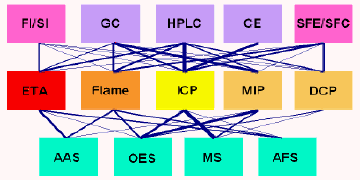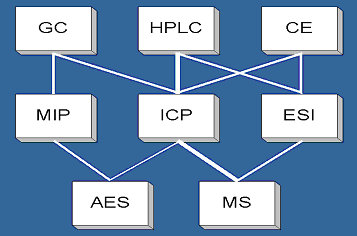The tools for chemical speciation analysis are manifold. Very few species-specific techniques do, however, allow direct speciation analysis. These include Mössbauer spectroscopy, X-ray photoelectron spectroscopy, Nuclear Magnetic Resonance (NMR), Electron Spin Resonance (ESR) and tandem mass spectrometry.
Most common tools for trace element speciation analysis are a combination of a separation technique coupled with a highly sensitive detection technique. In the early days such combinations consisted of a special sample preparation done off-line followed by the detection step. Today hyphenated techniques couple the separation technique on-line with the detection technique. The advantages of such hyphenated techniques are manyfold: a higher degree of automation, allowing for a higher sample throughput and a better reproducibility, a shorter analysis time, reducing the risk for species transformation during analysis, a reduction of contamination due to a closed system and a higher degree of information due to enhanced combined selectivity ofthe involved techniques. Different separation techniques have been successfully coupled with the most sensitive detection techniques. Especially during the early years, many different possibilities for coupling have been evaluated, as summarized in the following figure.

Fig.1: 1985-1995: "The joy of coupling"
Out of the pool of available separation techniques , liquid chromatography and gas chromatography do play a major role, but other non-chromatographic techniques such as capillary electrophoresis, dialysis, ultrafiltration, supercritical fluid extraction have also been used extensively. Since speciation analysis is most often seeking for information about trace and ultratrace element species, only the most sensitive techniques such as atomic fluorescence , absorption and emission spectrometry or mass spectrometry, can be considered. Different excitation sources have been used in conjunction with these techniques, such as furnaces (quartz and graphite furnace), flames and plasmas (microwave-induced plasma (MIP), inductively coupled plasma(ICP), direct current plasma (DCP) or glow discharge sources (GDS)). Today plasmas are the most important. Their main advantages are:
- continuous mode operation allowing relatively easy hyphenation with separation techniques
- high sensitivity for the elements of interest due to a plasma temperature which provides an ideal environment for atomic spectrometric detection
- simplified calibration, which may rely on one single standard, due to complete dissociation of compounds and/or linear behaviour over many orders of magnitude
- simultaneous detection that permits the calculation of empirical molecular formulae and/or allows for multi-element speciation analysis.
Today, commercial solutions are available for some of the hyphenated techniques applied for elemental speciation analysis. For other possible atomic spectrometric detection techniques, such as AAS and AFS there is, so far, little or no support by instrument manufacturers. Fig. 2 gives an overview of the commercially available hyphenated techniques.

Fig. 2: Actual techniques for speciation analysis: Concentration on the available
During the last 15 years speciation analysis was mainly driven by the possibilities provided by ICP-MS (isotope dilution, species specific isotope dilution analysis). About 1/3 of all publications use ICP-MS as detection system. While speciation analysis in the environmental and biological area is most often trace and ultra trace analysis, this is not necessarily the case for industrial applications.
 Further chapters on techniques and methodology for speciation analysis:
Further chapters on techniques and methodology for speciation analysis:
 Chapter 1:
Tools for elemental speciation
Chapter 1:
Tools for elemental speciation
 Chapter 2: ICP-MS - A versatile detection system for speciation analysis
Chapter 2: ICP-MS - A versatile detection system for speciation analysis
 Chapter 3: LC-ICP-MS - The most often used hyphenated system for speciation analysis
Chapter 3: LC-ICP-MS - The most often used hyphenated system for speciation analysis
 Chapter 4: GC-ICP-MS- A very sensitive hyphenated system for speciation analysis
Chapter 4: GC-ICP-MS- A very sensitive hyphenated system for speciation analysis
 Chapter 5: CE-ICP-MS for speciation analysis
Chapter 5: CE-ICP-MS for speciation analysis
 Chapter 6: ESI-MS: The tool for the identification of species
Chapter 6: ESI-MS: The tool for the identification of species
 Chapter 7: Speciation Analysis - Striving for Quality
Chapter 7: Speciation Analysis - Striving for Quality
 Chapter 8: Atomic Fluorescence Spectrometry as a Detection System for Speciation Analysis
Chapter 8: Atomic Fluorescence Spectrometry as a Detection System for Speciation Analysis
 Chapter 9: Gas chromatography for the separation of elemental species
Chapter 9: Gas chromatography for the separation of elemental species
 Chapter 10: Plasma source detection techniques for gas chromatography
Chapter 10: Plasma source detection techniques for gas chromatography
 Chapter 11: Fractionation as a first step towards speciation analysis
Chapter 11: Fractionation as a first step towards speciation analysis
 Chapter 12: Flow-injection inductively coupled plasma mass spectrometry for speciation analysis
Chapter 12: Flow-injection inductively coupled plasma mass spectrometry for speciation analysis
 Chapter
13: Gel electrophoresis combined with laser ablation inductively
coupled plasma mass spectrometry for speciation analysis
Chapter
13: Gel electrophoresis combined with laser ablation inductively
coupled plasma mass spectrometry for speciation analysis
 Chapter 14: Non-chromatographic separation techniques for speciation analysis
Chapter 14: Non-chromatographic separation techniques for speciation analysis
last time updated: October 9, 2025